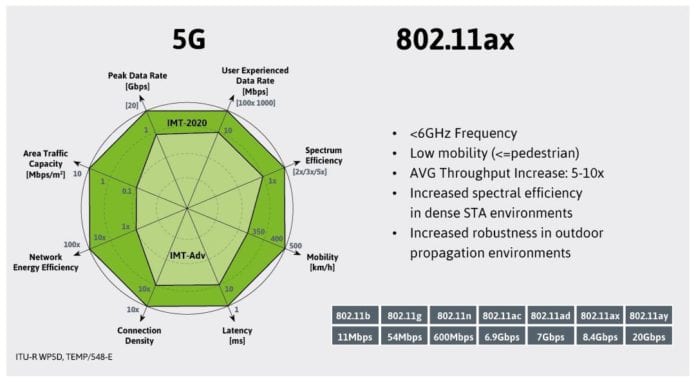While 5G will support unlicensed and shared spectrum, Wi-Fi has been moving in the other direction, taking on many characteristics of cellular technologies such as enhanced quality of service, security, and other features. As the lines between licensed and unlicensed spectrum blur, Wi-Fi will evolve alongside cellular and be part of the broader 5G platform, bringing 5G-like capabilities to non-spectrum owners such as cable operators, city authorities or private network providers.
As discussed in the WBA industry report, a good example is its rising support for densification, a key goal of the cellular community. The next iteration of the IEEE 802.11 standards on which Wi-Fi is based (802.11ax is particularly targeted at delivering gigabit data rates in dense environments) will also support this. As in cellular, where current advances in LTE are laying the groundwork for 5G in areas like density and power efficiency, so current developments in unlicensed spectrum technologies are pointing the way to 5G-like capabilities, especially in 802.11/Wi-Fi. The fastest commercial Wi-Fi standard, 802.11ac Wave 2, supports multi-gigabit data rates, while 802.11ad (WiGig) is blazing the trail for mainstream wireless broadband technologies in mmWave bands (60 GHz).
The first pre-standard 802.11ax chipsets have appeared from Qualcomm, Quantenna, and Broadcom, enabling equipment makers and users to sample this technology before its full specifications — seen as the first ‘5G’ 802.11 release — are finalized in 2018. Also, the draft standard, 802.11ay, is targeted to be completed by the end of 2017 and will support higher throughput and lower latency for 60 GHz.

Other emerging features are geared to high-quality enterprise and indoor markets and dense outdoor hot zones, just like cellular 5G. For instance, the Wi-Fi Alliance recently introduced a certification program called Wi-Fi Vantage, which includes 802.11ac, Passpoint and two new technologies, Agile Multiband and, later in the year, Optimized Connectivity.
Agile Multiband helps ensure that a user has the best available signal by identifying the best AP, band, and channel and steering the device to that connection. Agile Multiband also re-authenticates devices with WPA2 security sufficiently quickly for a user to continue a VoIP conversation while moving between APs without dropping the call.
Optimized Connectivity speeds up the discovery of available APs and simplifies initial authentication and IP layer connectivity. It also reduces management traffic between a device and an AP.By making it simpler for users to receive a strong signal and to move around within a large, dense urban or enterprise network, these technologies help create a cellular-like experience and can support managed and neutral host platforms.
As presented in the industry report, the WBA has identified areas where 802.11 technologies outperform the base requirements for IMT-2020 (5G) and ones where future work will be needed to bring Wi-Fi into line with 5G cellular. Wi-Fi can outperform the IMT-2020 requirements related to area traffic capacity and latency, but whereas network efficiency values are above those associated with IMT-Advanced ($g), and they do not meet the target requirements for IMT-2020. A key priority is to enhance 802.11 standards for vehicular use cases at higher speeds than supported by the current 802.11p.
The figure below summarizes this. With each technology having its strengths and weaknesses, it is essential that operators can use a combination of 802.11 and 3GPP (and other) connections to achieve the best overall performance.

Access the full industry report now

